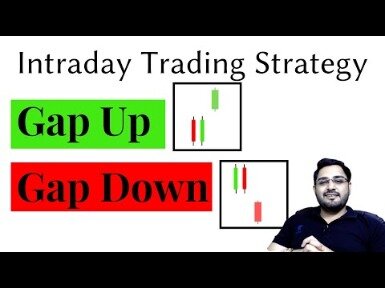Table of Contents
- Bullish Engulfing Chart Pattern
- What Is Gap? How To Use Gap Strategy For Trading
- Gap Basics
- Trading Documentation
- What Does Gap Up And Gap Down Mean?
This means the stock price will move back to its original level. Because of the volatility around earnings season, this is typically a time when stocks will make large price movements. A psychological reason for this is that it’s not uncommon for analysts to be overly pessimistic and push a stock down too much. In this case, there will almost always be a correction as the market absorbs the news and investors push the stock higher. If the movement is done without firm support and resistance levels, the stock may revert back because there is nothing to keep it anchored at that level. Also, exhaustion gaps are more likely to be filled since they happen at the end of a pricing pattern.
Individual investors are the ones who tend to get overly enthusiastic about a stock. This plays into the hand of institutional investors who may support the trend in order to boost their portfolios. If the gap of a stock has started to fill, it will almost always continue in that direction. This is because the stock has no immediate support and resistance. Breakaway Gaps– These are gaps that take place at the end of a pricing pattern and signal the start of a new trend.
Bullish Engulfing Chart Pattern
A decent example of this is the exhaustion gap that occurred in the 20+ Year Treasury ETF in December 2008. A good confirmation for trading gaps is whether or not they are associated with classic chart patterns. For example, if an ascending triangle suddenly has a breakout gap to the upside, this can be a much better trade than a breakaway gap without a good chart pattern associated with it. The chart below shows the normally bullish ascending triangle with a breakaway gap to the upside, as you would expect with an ascending triangle. The runaway gap or continuation gap occurs in an already existing trend and suggests a future continuation of that trend.

We can see there is little support below the gap, until the prior support . A trader could also short the currency on the way down to this point and try to identify a top. The large candlestick identified by the left arrow on this GBP/USD chart is an example of a gap found in the forex market. This does not look like a regular gap, but the lack of liquidity between the prices makes it so.
What Is Gap? How To Use Gap Strategy For Trading
Applied Materials saw a downside breakaway gap on high volume in August, consolidated for a week or two, and has been trending lower since. The stock gapped above resistance on high volume, based for two months, and then continued higher. It’s gone on to rally roughly 500% since that breakaway gap. A gap “getting filled” is when price action at a later time retraces to the closing price of the day preceding the gap. Once it’s retraced fully, then the gap is considered filled.
Enter any stocks you own or are interested in, into your folio – Name or ticker is fine. I’d like to view FOREX.com’s products and services that are most suitable to meet my trading needs. Trade with a global market leader with a proven track record of financial strength and reliability. Take our personality quiz to find out what type of trader you are and about your strengths. Take control of your trading with powerful trading platforms and resources designed to give you an edge. Trade a wide range of forex markets plus spot metals with low pricing and excellent execution. Reproduction of news articles, photos, videos or any other content in whole or in part in any form or medium without express writtern permission of moneycontrol.com is prohibited.
When gaps get filled within the same trading day as they occur, the gap is said to have undergone fading. For example, let’s consider a stock that closed at $39 after having traded as high as $41 during that trading session.
Gap Basics
© 2021 Market data provided is at least 10-minutes delayed and hosted by Barchart Solutions. Information is provided ‘as-is’ and solely for informational purposes, not for trading purposes or advice, and is delayed. To see all exchange delays and terms of use please see disclaimer. Fundamental company data provided by Zacks Investment Research.
As a result, many investors will want to own a stock if the news is good and sell the stock on the contrary. If a stock lost a huge percentage in the aftermarket or pre-market, it will most likely have a gap down when the market opens. In order to succeed at trading, you need discipline, patience and proper risk management.
These gaps are common (get it?) and usually get filled fairly quickly. “Getting filled” means that the price action at a later time usually retraces at the least to the last day before the gap. Here is a chart of two common gaps that have been filled. Notice how, following the gap, the prices have come down to at least the beginning of the gap; this is called closing or filling the gap. An opening gap is a temporary gap that changes its name by the end of the close.
Trading Documentation
Support and resistance lines are technical indicators that traders can use to set price targets. When a stock gaps up, it usually doesn’t leave behind a support or resistance line to anchor that price level. Finally, the type of price pattern can indicate whether a gap will be filled. For example, exhaustion gaps come at the end of a price pattern, making them more likely to be filled. Breakaway and continuation gaps, which are confirming the direction of a trend, are less likely to be filled. If you’re new to gap trading, it is important to look at stocks that are trading with a high volume .
While viewing FlipCharts, you can apply a custom Chart Template, further customizing the way you can analyze the symbols. Enter your email address below to receive a concise daily summary of analysts’ upgrades, downgrades and new coverage with MarketBeat.com’s FREE daily email newsletter.
Playing The Gap
If a runaway gap is filled within a few price bars after the gap, then it likely is an exhaustion gap. With an exhaustion gap, prices either consolidate horizontally or reverse downward. The TC2000 Pullback Strength scan is a bullish scan that returns stocks trading in established uptrends that have recently experienced a short-term pullback. The TC2000 Bear Pullback scan is a bearish scan that returns stocks trading in established downtrends that have rallied briefly but are now rolling back over. The scan will return small gap downs starting at just 1% below the previous day’s lows as well as large gap downs that could be caused by earnings or some other market catalyst.

In almost every case, this will result in a correction. Another reason may be due to a lack of support and resistance.
The talking heads on the financial stations are all expressing their opinions about how this company/industry is in the trash can. Finally the last holdouts cannot stand the pain of owning that stock anymore. Once this gap is spotted, a variety of profitable trading procedures can be put in place. Upon a slight to medium gap up, the Candlestick investor should put their stop at the close of the previous day. The logic being that if the price gapped up, indicating that the top is in, and the price came back down through the close of the previous day, the buying was not sustained.
This setup lends itself well to a gap fill target and well-defined placement for stop losses . There are limitations despite gaps being easy to spot.
The other requirement for this method is that the stock should be trading on at least twice the average volume for the last five days. This method is only recommended for those individuals who are proficient with the eight strategies above and have fast trade execution systems. Since heavy volume trading can experience quick reversals, mental stops are usually used instead of hard stops. If there is not enough interest in selling or buying a stock after the initial orders are filled, the stock will return to its trading range quickly. Entering a trade for a partially gapping stock generally calls for either greater attention or closer trailing stops of 5-6%. Each of the four gap types has a long and short trading signal, defining the eight gap trading strategies. The basic tenet of gap trading is to allow one hour after the market opens for the stock price to establish its range.












